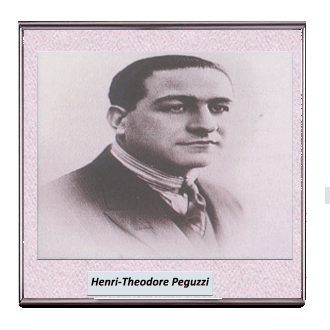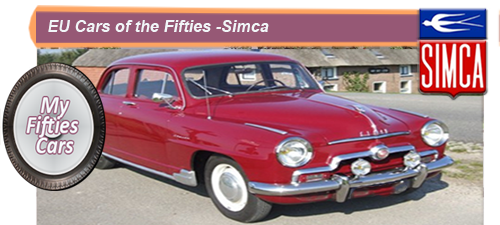
Agnelli took a liking to Pigozzi, and the pair struck a business relationship with Pigozzi, firstly with Pigozzi’s company handed the contract to supply Fiat with scrapped automobile bodies which Fiat was always in need of for recycling purposes.
As the relationship between the two deepened, Agnelli, impressed with Pigozzi’s flair and business acumen, in 1926, appointed him the primary agent for Fiat for France.
Two years later, Pigozzi’s French company (Société Anonyme Français des Automobiles FIAT) SAFAF acquired large premises in the Paris suburb of Suresnes, where he began to assemble Fiats for sale in France, even licensing production of several parts to local suppliers.
By the mid-Thirties, up to 30,000 Fiat cars were being sold annually by SAFAF.At the end of 1934, Pigozzi, on the lookout for larger premises to deepen his association with Fiat further, discovered that the Donnet-Zédel vehicle production plant in Nanterre was available for sale.
Ever thinking forward, Pigozzi was undeterred that Donnet-Zédel had gone bankrupt just a few months previously, a victim of the significant downturn in demand during the recession that had struck France as well as most of Western Europe.
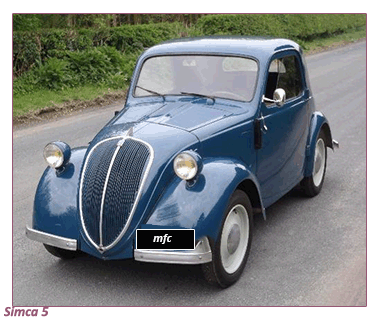 Not one to back away from risk, Pigozzi had his production plant, which he named Société Industrielle de Mécanique et Carrosserie Automobile, or Simca for short, fully operational in early December of 1934, producing almost exact duplicates of current Fiat models.
Not one to back away from risk, Pigozzi had his production plant, which he named Société Industrielle de Mécanique et Carrosserie Automobile, or Simca for short, fully operational in early December of 1934, producing almost exact duplicates of current Fiat models.
Simca proved an ideal working relationship for both Pigozzi and Fiat with the company gradually climbing the sales chart until they became the fourth largest car manufacturers in France, behind Renault, Citroen, and Peugeot.
This comfortable situation looked like it would continue indefinatley until the peace in Europe was shattered by the outbreak of the Second World War.
With the defeat of France Simca was ordered by the Nazi occupiers to switch production towards the war effort, although the plant did, almost openly, continued to produce a minimal amount of private cars for sale on the open market.
![]()
The flexibility that Simca received from the Nazis added to the fact that Allied bombers rarely attacked the plant has been long a subject of discussion among auto historians.
Conspiracy theories have often been heard that Agnelli had some say in why Simca continued to produce cars while their main rivals were disallowed. Why the Simca plant at Nanterre was rarely under fire has never been explained. If there was a price to be paid for enjoying the benefits of his association with Agnelli, Pigozzi paid for it in full following the 1944 liberation. Simca’s association with Fiat became a significant liability in post-war France, still smarting from four years of Germany’s occupation.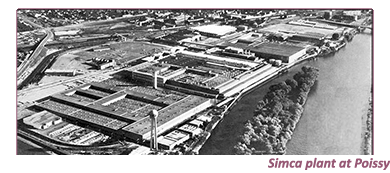 If the company had been dependent on domestic sales, they might well have gone into liquidation.
Thankfully the American administration, anxious to maintain stability and keep people working, awarded Simca a large-scale contract from the US Army to repair large numbers of Jeep engines.
If the company had been dependent on domestic sales, they might well have gone into liquidation.
Thankfully the American administration, anxious to maintain stability and keep people working, awarded Simca a large-scale contract from the US Army to repair large numbers of Jeep engines.
 This agreement provided Simca with some valuable breathing space which they were able to take advantage.
Much is it may have been unpalatable to many; there was no escaping the fact that Simca were the only French company that could produce cars in commercial quantities, at a time when there was a high demand.
This agreement provided Simca with some valuable breathing space which they were able to take advantage.
Much is it may have been unpalatable to many; there was no escaping the fact that Simca were the only French company that could produce cars in commercial quantities, at a time when there was a high demand.
 Simca took a very prominent place at the first post-war Paris Motor Show, displaying two brand new models, the Five and the Eight, both of which bore a powerful resemblance to their pre-war equivalents.
The first genuine post-war car released by Simca was the Six, which debuted in 1948. Powered by a 570-cc engine, the Simca Six was the first car in the Fiat/Simca relationship to be launched ahead of the corresponding Fiat model.
The Simca Six proved to be a commercial success, with more than 20,000 cars sold within three years of its launch, the bulk for export.
In 1951, Simca made another breakthrough with the introduction of the monocoque bodied Aronde, the first car produced by the company that was not a Fiat clone.
Simca took a very prominent place at the first post-war Paris Motor Show, displaying two brand new models, the Five and the Eight, both of which bore a powerful resemblance to their pre-war equivalents.
The first genuine post-war car released by Simca was the Six, which debuted in 1948. Powered by a 570-cc engine, the Simca Six was the first car in the Fiat/Simca relationship to be launched ahead of the corresponding Fiat model.
The Simca Six proved to be a commercial success, with more than 20,000 cars sold within three years of its launch, the bulk for export.
In 1951, Simca made another breakthrough with the introduction of the monocoque bodied Aronde, the first car produced by the company that was not a Fiat clone.
![]()
 An entirely new Simca made its first appearance in 1961 at the Paris Motor Show: the Simca 1000.
The 1000 was the first Simca to be fitted with a rear-mounted engine, with a body style that was a complete departure from the previous Simcas.
An entirely new Simca made its first appearance in 1961 at the Paris Motor Show: the Simca 1000.
The 1000 was the first Simca to be fitted with a rear-mounted engine, with a body style that was a complete departure from the previous Simcas.
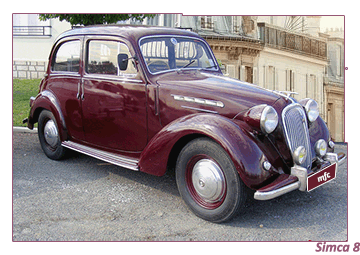 The formula seemed to work with the Ariana being replaced by the Simca 1300 and 1500 two years later.
The formula seemed to work with the Ariana being replaced by the Simca 1300 and 1500 two years later.
With demand for Simca reaching unprecedented peaks, in 1954, Pigozzi acquired the former Ford's factory at Poissy.
Simca not only took over the plant in its entirety, they also assumed production of a current Ford model, the Vedette, marketed as a Simca Vedette.
The Vedette was a roomy six-seater powered by a side-valve V-8 engine was a departure from Simca’s standard product range focused on the compact to medium range.
In the Spring of 1957, Simca also began to produce the Ariane at the Poissy plant. To even the most casual of observers, the Ariane was little more than a more economical four-cylinder engined version of the Aronde.
With Simca's sales going from strength to strength, and with their new Poissy produced models possessing a distinctly North American feel, it was little wonder that representatives from the US car industry began to cast an eye over the company.
The most adventurous of the bunch was s Chrysler who, from 1958, began to silently and secretly pick up blocks of shares in Simca — eventually acquiring a controlling interest.
With Chr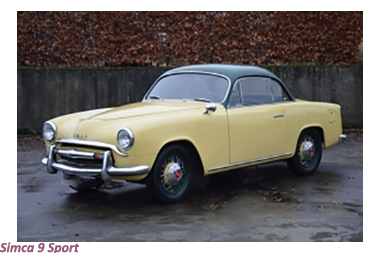 ysler influence being barely felt during the Sixties, Simca were still reasonably autonomous.
ysler influence being barely felt during the Sixties, Simca were still reasonably autonomous.
That situation began to change subtly in 1964 driven by the sudden and unexpected passing of Henri-Theodore Pigozzi at the age of 76.
Until almost the day of his passing Pigozzi had remained as central a figure at Simca as when he founded the company nearly three decades previously.
 >Without their figurehead, Simca began to gradually lose some of their direction, although they did launch one of their most successful models, 1100, in 1968.
>Without their figurehead, Simca began to gradually lose some of their direction, although they did launch one of their most successful models, 1100, in 1968.
In 1970 Simca disappeared into history, when Chrysler increased their share in the company to 99.3 per cent, changing the name of the company shortly after to Chrysler France.
